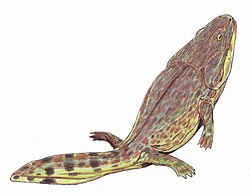Paleobiota
| Extinct taxa of the Camp Springs Conglomerate | |||||
|---|---|---|---|---|---|
| Genus / Taxon | Species | Material | Notes | Images | |
| Buettnererpeton [2] | B. bakeri | A metoposaurid temnospondyl amphibian known from the Elkins Place bone bed. Previously considered a species of Metoposaurus . |  | ||
| Wannia [3] | W. scurriensis | A basal (non-mystriosuchine) phytosaur. Previously considered a species of Paleorhinus . | |||